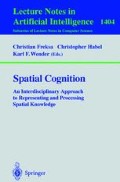Abstract
In two experiments we investigated the use of German locative expressions as a function of the spatial relation between a reference object (RO) and a to-be-located object (LO). In the experiments, a speaker described to another participant, by locative expressions, where LO can be found in relation to RO. LO (a blue dot) was presented at different positions around RO (a red dot). The listener saw RO only, and her or his task was to find LO by moving a small window over the screen using the computer mouse. The positions of LO were circularly arranged around RO and their angular relations were varied in steps of 15 degrees. In Experiment 1, only the four canonical expressions (left/right, above/below) and their single composites were allowed. In Experiment 2, no constraints were made. Both experiments yielded comparable results. The canonical expressions were used nearly exclusively for prototypical relations, and their production latencies were the shortest. Composites were used for all non-prototypical relations. There was only a small spatial area next to the canonical directions in which two different locative expressions were used, and in these areas of competition the longest production times were observed. Thus, canonical expressions were used in a much smaller area around the prototypical axes than predicted by selection rules based on applicability ratings obtained in meta-linguistic judgments.
This research was supported by a grant from the German Research Foundation in the Special Research Division SFB 378 ‘Resource-Adaptive Cognitive Processes’.
Access this chapter
Tax calculation will be finalised at checkout
Purchases are for personal use only
Preview
Unable to display preview. Download preview PDF.
References
Bryant, D. J., Tversky, B. & Franklin, N. (1992). Internal and external spatial frameworks for representing described scenes. Journal of Memory and Language, 31, 74–98.
Franklin, N., Henkel, L. A. & Zangas, T. (1995). Parsing surrounding space into regions. Memory and Cognition, 23, 397–407.
Franklin, N. & Tversky, B. (1990). Searching imagined environments. Journal of Experimental Psychology: General, 119, 63–76.
Gapp, K.-P. (1995). An empirically validated model for computing spatial relations. In I. Wachsmuth, C.-R. Rollinger, and W. Brauer (Ed.), KI-95: Advances in artifical intelligence. Proceedings of the 19th Annual German Conference on Artifical Intelligence (pp. 245–256). Berlin, Heidelberg: Springer.
Gapp, K.-P. (1997). Objektlokalisation: Ein System zur sprachlichen Raumbeschreibung. [The localization of objects: A system for verbal description of locations.] Wiesbaden: Deutscher Universitätsverlag.
Glaser, W. R. & Glaser, M. O. (1989). Context effects in Stroop-like word and picture processing. Journal of Experimental Psychology: General, 118, 13–42.
Grabowski, J., & Weiß, P. (1996). Determinanten der Interpretation dimensionaler Lokalisationsäußerungen: Experimente in fünf Sprachen. [Factors that determine the interpretation of dimensional spatial expressions: experiments in five languages.] Sprache & Kognition, 15, 234–250.
Hayward, W. G. & Tarr, M. J. (1995). Spatial language and spatial representation. Cognition, 55, 39–84.
Herrmann, T. (1996). Blickpunkte und Blickpunktsequenzen. [Points of view and point of view sequences.] Sprache & Kognition, 15, 159–177.
Herskovits, A. (1985). Sematics and pragmatics of locative expressions. Cognitive Science, 9, 341–378.
Herskovits, A. (1986). Language and Spatial Cognition. An interdisciplinary Study of the Preposition in English. Cambridge, London: Cambridge University Press.
Klein, W. (1994). Keine Känguruhs zur Linken. [No kangaroos at the left.] In H. J. Kornadt, J. Grabowski & R. Mangold-Allwinn (Eds.), Sprache und Kognition: Perspektiven moderner Sprachpsychologie (pp. 163–182). Heidelberg: Spektrum.
Levelt, W. J. M. (1989). Speaking: From intention to articulation. Cambridge: MIT Press.
Logan, G. D. (1995). Linguistic and conceptual control of visual spatial attention. Cognitive Pychology, 28, 103–174.
Logan, G. D. & Sadler, D. D. (1996). A computational analysis of the apprehension of spatial relations. In P. Bloom, M. A. Peterson, L. Nadel & M. F. Garrett (Eds.), Language and space. Language, speech, and communication (pp. 493–529). Cambridge, MA: MIT Press.
Pechmann, T, Reetz, H., & Zerbst, D, (1989). Kritik einer Meßmethode: Zur Ungenauigkeit von voicekey Messungen. [The unreliability of voice key measurements.] Sprache & Kognition, 8, 65–71.
Retz-Schmidt, G. (1988). Various views on spatial prepositions. AI Magazine, 9(2), 95–105.
Author information
Authors and Affiliations
Editor information
Editors and Affiliations
Rights and permissions
Copyright information
© 1998 Springer-Verlag Berlin Heidelberg
About this chapter
Cite this chapter
Zimmer, H.D., Speiser, H.R., Baus, J., Blocher, A., Stopp, E. (1998). The Use of Locative Expressions in Dependence of the Spatial Relation between Target and Reference Object in Two-Dimensional Layouts. In: Freksa, C., Habel, C., Wender, K.F. (eds) Spatial Cognition. Lecture Notes in Computer Science(), vol 1404. Springer, Berlin, Heidelberg. https://doi.org/10.1007/3-540-69342-4_11
Download citation
DOI: https://doi.org/10.1007/3-540-69342-4_11
Published:
Publisher Name: Springer, Berlin, Heidelberg
Print ISBN: 978-3-540-64603-7
Online ISBN: 978-3-540-69342-0
eBook Packages: Springer Book Archive

